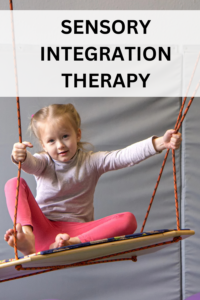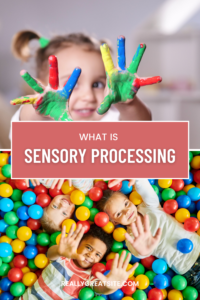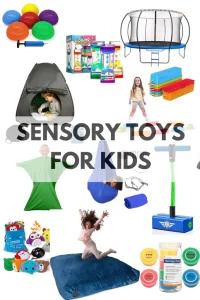
A Comprehensive Guide to Sensory Integration Therapy for Children
Are you a parent or caregiver to a child with sensory processing difficulties? Maybe you have just started occupational therapy and have heard of sensory integration therapy but aren’t really sure what it is.
Well, I’m here to help. Sensory integration therapy can be a powerful intervention strategy for both children and adults with sensory processing difficulties. Join me as we take a deep dive into what sensory integration is and why it is so beneficial.

Parenting a child with sensory processing difficulties can be both rewarding and challenging. Understanding your child’s unique sensory needs is crucial for providing the support and care they require.
Sensory integration therapy, a therapeutic approach developed by occupational therapists, is designed to address these challenges and promote optimal sensory processing in children, leading to improved functional skills.
Hi! My name is Marra, and I’m a mama and a pediatric occupational therapist who has years of experience working with children with sensory processing difficulties and helping their parents navigate the ups and downs of child development.
I loved being a support person for parents learning about autism, sensory processing, sensory integration therapy, and their child’s individual needs. I love empowering parents to trust themselves while advocating for their children.
In this blog post, we’ll explore what sensory integration therapy is, how it works, and how it can positively impact children with sensory processing difficulties.
What is Sensory Processing?
Sensory processing refers to our ability to receive information from the environment through our 8 sensory systems, filter it, make sense of it, and then choose an appropriate response. We do this all the time, even when we are asleep.
Yes, we do have 8 sensory systems. We have 5 that are more well-known, including what we see, hear, taste, touch, and smell. In addition, we have 3 less well-known sensory systems including our vestibular, proprioceptive, and interoceptive sensory systems.
Our vestibular sense is our sense of balance, and it is our response to gravity. It is how we move around our environment without falling over. Our proprioceptive sensory system is our sense of deep pressure and body awareness. Interoception is our sense of how our body is feeling, such as when we are hot, tired, or hungry.
So much information comes into our brains all of the time, and it is a lot to process, especially for young children. We all process sensory information differently, and our bodies vary on what type of sensory input we need to maintain a calm, regulated state.
If you would like to learn more about sensory processing and our 8 sensory systems, check out the post below.

Understanding Sensory Processing Difficulties
Children with sensory processing difficulties may struggle with processing and responding to sensory input, which can lead to challenges in daily activities and social interactions. We all vary in our sensory processing abilities, however, some struggle more than others
Sensory processing difficulties can manifest in various ways, including hypersensitivity (overreacting to stimuli), hyposensitivity (underreacting to stimuli), and difficulty with sensory discrimination (differentiating between stimuli).
Common sensory processing difficulties may involve sensitivities to light, sound, touch, taste, or smell, as well as challenges in motor coordination and body awareness.

What is Sensory Integration Therapy?
Sensory integration therapy, also known as sensory integration or SI therapy, is an evidence-based therapeutic approach developed by occupational therapist Dr. Jean Ayres.
The primary goal of this therapy is to help individuals effectively process and respond to sensory information from the environment, enhancing their ability to participate in daily activities and engage with others.
The therapy is rooted in the concept of neuroplasticity, the brain’s ability to reorganize and adapt by forming new neural connections throughout life. Sensory integration therapy is particularly beneficial for children, as their brains are still developing, and interventions at an early age can have a profound impact on their sensory processing abilities.

how sensory integration therapy works
Sensory integration therapy involves a personalized, child-centered approach that focuses on creating a sensory-rich environment to encourage adaptive responses. The therapist works closely with the child to develop activities that challenge and stimulate the sensory system in a structured and meaningful way. Here are key components of how sensory integration therapy works:
1. Assessment: Before starting sensory integration therapy, a thorough assessment is conducted to understand the child’s sensory processing difficulties. This may include observation, interviews with parents, and standardized assessments to identify specific sensory challenges.
2. Individualized Treatment Plan: Based on the assessment findings, the occupational therapist develops an individualized treatment plan tailored to the child’s unique needs. This plan outlines specific activities and interventions to address sensory processing difficulties.
3. Sensory-rich Activities: Sensory integration therapy involves engaging the child in a variety of activities designed to provide controlled exposure to sensory stimuli. These activities may include swinging, jumping, climbing, tactile experiences, and more. The goal is to help the child modulate their responses to sensory input.
4. Gradual Progression: Therapy sessions are structured to gradually increase the complexity and intensity of sensory experiences. This helps the child build tolerance and adaptability to different stimuli, fostering improved sensory processing.
5. Parent Involvement: Parents play a crucial role in the success of sensory integration therapy. They are often encouraged to participate in therapy sessions, learn about sensory strategies, and incorporate sensory-rich activities into the child’s daily routine at home.

benefits of sensory integration therapy
Sensory integration therapy offers a range of benefits for children with sensory processing difficulties. Here are some key advantages:
1. Improved Sensory Processing: The core objective of sensory integration therapy is to enhance the child’s ability to process and respond to sensory information effectively. Over time, this can lead to improvements in sensory modulation and integration.
2. Enhanced Motor Skills: Many children with sensory processing difficulties experience challenges in motor coordination and planning. Sensory integration therapy targets these areas, promoting the development of gross and fine motor skills.
3. Better Social Interaction: Improved sensory processing can positively impact a child’s ability to engage in social interactions. Children may feel more comfortable and confident in social situations by reducing sensitivities and enhancing self-regulation
4. Increased Attention and Focus: Sensory integration therapy can contribute to better attention and concentration. By addressing sensory challenges, the child may experience fewer distractions and an increased ability to focus on tasks
5. Emotional Regulation: Sensory processing difficulties can often lead to emotional dysregulation. Through sensory integration therapy, children learn to self-regulate their emotional responses to various stimuli, promoting emotional well-being.
6. Promotion of Independence: As children develop better sensory processing abilities, they become more independent in daily activities. This includes self-care tasks, school-related activities, and play.

Sensory Integration Tips for Parents
In addition to participating in sensory integration therapy sessions, there are several ways parents can support their child’s sensory needs at home:
1. Create a Sensory-Friendly Environment: Designate specific areas at home where your child can engage in sensory-rich activities. This might include a quiet corner with soft lighting, a sensory bin with various textures, or a designated space for movement activities.
2. Establish Consistent Routines: Children with sensory processing difficulties often benefit from predictable routines. Establishing consistent daily schedules can help them feel more secure and in control.
3. Provide Sensory Breaks: Recognize when your child may need a sensory break and allow them time to engage in calming activities. This could involve deep pressure activities, fidget tools, or a short break in a quiet space.
4. Offer Choices: Allow your child to have choices in their daily activities. This empowers them and can help them feel more in control, reducing anxiety related to sensory challenges.
5. Communicate with Teachers and Occupational Therapists Keep an open line of communication with your child’s teachers and occupational therapist to ensure they are aware of and can accommodate sensory needs in the school environment. Collaboration between home and school is essential for holistic support.

Sensory integration therapy is a valuable tool in supporting children with sensory processing difficulties. By addressing the root causes of sensory challenges and providing tailored interventions, occupational therapists can make a significant impact on a child’s overall well-being and development.
As a parent, being actively involved in your child’s sensory integration journey, both in therapy sessions and at home, can contribute to their success and happiness.
Remember, every child is unique, and progress may vary. Celebrate the small victories, stay patient, and continue to advocate for your child’s sensory needs. With the right support and understanding, you can create an environment that nurtures your child’s comfort and helps them thrive.
